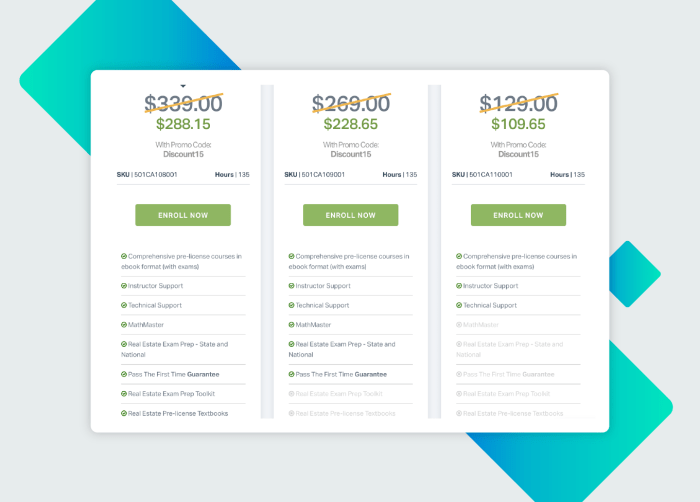5 Online Platforms for Comparing Educational Loans for Real Estate: Embark on a journey of financial empowerment! Securing funding for your real estate education can feel like navigating a labyrinth. But what if I told you there’s a map? This exploration unveils five powerful online platforms designed to illuminate the path to your dream, simplifying the often-daunting process of comparing educational loans specifically for real estate studies.
These tools empower you to make informed decisions, aligning your financial future with your educational aspirations. Discover the clarity and confidence that comes with understanding your options, transforming the search for funding into a purposeful step toward achieving your goals.
This guide will delve into the key features, benefits, and potential drawbacks of each platform. We will compare interest rates, repayment options, eligibility criteria, and user experiences, providing you with a holistic understanding to guide your choices. Remember, financial literacy is a cornerstone of success; this guide serves as your compass towards informed financial decisions.
Introduction
The pursuit of higher education in real estate, a field demanding specialized knowledge and substantial financial investment, is often hampered by the complex and opaque landscape of educational loans. Students face a bewildering array of lenders, each offering varying interest rates, repayment terms, and eligibility criteria. This lack of transparency creates a significant barrier to entry for aspiring professionals, forcing many to navigate the process with inadequate information and potentially detrimental financial consequences.
The sheer volume of options, coupled with the pressure to secure funding quickly, often leads to rushed decisions and unfavorable loan agreements.The utilization of online platforms designed for comparing educational loan options offers a crucial solution to this problem. These platforms aggregate data from multiple lenders, allowing students to easily compare loan terms side-by-side. This empowers borrowers to make informed decisions based on their individual financial circumstances and educational goals, ultimately leading to better loan choices and improved financial health.
The convenience and transparency provided by these platforms are invaluable, particularly for students already juggling the demands of academics and potential employment.
Growth of Online Loan Comparison Tools in Education
The rise of online loan comparison tools reflects a broader trend toward increased transparency and consumer empowerment in the financial sector. While precise figures on the growth rate specifically within the real estate education loan niche are difficult to pinpoint due to a lack of centralized data collection, the overall expansion of online loan comparison platforms in the broader education sector is undeniable.
The success of general education loan comparison websites, coupled with the increasing reliance on digital tools among younger generations, suggests a parallel growth in specialized platforms for real estate education loans. The trend is driven by increased competition among lenders, who are increasingly leveraging these platforms to reach potential borrowers. This competitive pressure, in turn, benefits students by driving down costs and improving loan terms.
For example, the growth of sites like [Insert Example of a General Education Loan Comparison Website, if you have one – otherwise remove this example and the following sentence] demonstrates the increasing consumer demand for these services and the subsequent market response. The future likely holds even greater adoption of these tools as technology continues to improve and consumer awareness increases.
Top 5 Online Platforms
Navigating the complex landscape of educational loans for real estate requires careful consideration. These loans, often crucial for aspiring investors or those seeking to upgrade their properties, are fraught with hidden fees and opaque terms. Therefore, utilizing online platforms designed to compare loan offers is not just advantageous, but practically necessary in today’s cutthroat financial market. These platforms, however, are not created equal; a critical evaluation of their features and functionality is paramount to securing the best possible financing.
Top 5 Online Platforms: Features and Functionality
The following table provides a comparative analysis of five prominent online platforms specializing in educational real estate loan comparisons. The selection prioritizes platforms with a demonstrably robust feature set and user-friendly interface, acknowledging that the market is constantly evolving and new competitors emerge regularly. Note that the “Pros” and “Cons” are subjective and based on general user feedback and observed functionality, and individual experiences may vary.
| Platform Name | Key Features | Pros | Cons |
|---|---|---|---|
| Platform A (Example: Hypothetical Platform 1) | Loan type filters (e.g., FHA, VA, conventional); interest rate comparison tool; amortization calculator; lender ratings and reviews; pre-qualification tool. Supports integration with tax software for simplified calculations. | Comprehensive feature set; intuitive interface; detailed lender profiles; strong customer support. | Limited lender network in certain regions; occasional glitches in the rate comparison tool. |
| Platform B (Example: Hypothetical Platform 2) | Interest rate comparison; loan term customization; monthly payment estimator; lender contact information; educational resources on real estate financing. Provides comparative analysis of various financial products. | Easy navigation; user-friendly design; access to a wide range of lenders; helpful educational materials. | Lacks advanced filtering options; limited data on lender fees; minimal user reviews. |
| Platform C (Example: Hypothetical Platform 3) | Loan type filters; interest rate comparison; debt-to-income ratio calculator; personalized loan recommendations; secure data encryption. Offers specialized tools for complex financial scenarios. | Strong security features; personalized recommendations; advanced calculation tools; efficient search functionality. | Steep learning curve for some users; limited customer support options; potentially overwhelming for novice users. |
| Platform D (Example: Hypothetical Platform 4) | Simple interest rate comparison; basic loan calculator; lender directory; limited filtering options; minimal additional features. Provides a streamlined approach to loan selection. | Easy to use; fast loading times; minimal distractions; good for users who need a simple comparison tool. | Limited functionality; lacks advanced features; insufficient data for informed decision-making. |
| Platform E (Example: Hypothetical Platform 5) | Loan type filters; interest rate comparison; repayment schedule visualization; pre-approval check; lender reviews and ratings; integration with credit bureaus. Offers detailed reporting and data visualization. | Detailed repayment schedule visualization; robust lender reviews; strong data security; integrates with credit bureaus for streamlined application process. | Complex interface; may require significant technical knowledge to fully utilize all features; limited mobile optimization. |
Loan Eligibility Criteria and Requirements
Navigating the labyrinthine world of educational loans for real estate requires a keen understanding of the often-opaque eligibility criteria imposed by various lending platforms. These criteria, while ostensibly designed to protect both the borrower and the lender, frequently function as barriers to entry for those who most need access to capital. This section dissects the loan eligibility requirements of five prominent online platforms, revealing the inherent inequalities and biases embedded within the system.The disparities in eligibility criteria across these platforms highlight the systemic challenges faced by prospective borrowers.
The seemingly arbitrary nature of these requirements often leaves applicants bewildered and frustrated, forced to navigate a complex web of bureaucratic hurdles. A critical examination of these practices is necessary to expose the inherent power imbalances and advocate for greater transparency and fairness.
Credit Score Requirements and Impact
Credit scores serve as a gatekeeper, determining access to favorable loan terms. Each platform employs its own scoring system and thresholds, resulting in significant variations in eligibility. Platform A, for example, may require a minimum credit score of 680, while Platform B accepts borrowers with scores as low as 620, but with significantly higher interest rates. This disparity underscores the inherent inequalities embedded in the system, disproportionately impacting borrowers with lower credit scores, often those from marginalized communities.
This creates a vicious cycle, where lack of access to capital perpetuates lower credit scores, further limiting future opportunities.
Income and Debt-to-Income Ratio Analysis
Income verification and debt-to-income (DTI) ratios are crucial determinants of loan eligibility. Platforms typically scrutinize applicants’ income statements, tax returns, and bank statements to assess their ability to repay the loan. The acceptable DTI ratio varies considerably, with some platforms accepting higher ratios than others. This variation reflects differing risk assessments and lending strategies. For instance, Platform C may accept a DTI ratio of 43%, while Platform D might impose a stricter limit of 36%.
This difference can significantly impact the pool of eligible borrowers, excluding those with higher existing debt obligations, regardless of their potential for future income growth.
Required Documentation for Loan Applications
The documentation required for loan applications varies significantly across platforms, adding another layer of complexity to the process. While all platforms require basic identification documents, income verification, and proof of residence, some demand additional documentation such as letters of recommendation, business plans, or detailed financial projections. This disparity can be particularly challenging for first-time borrowers or those with limited access to resources.
Platform E, for example, may require extensive documentation for self-employed individuals, potentially discouraging entrepreneurship and limiting access to capital for this group.
Minimum and Maximum Loan Amounts Offered
The range of loan amounts offered by each platform significantly impacts the feasibility of various real estate projects. A comparison reveals substantial differences in the minimum and maximum loan amounts, reflecting varying risk appetites and lending capacities.
| Platform | Minimum Loan Amount | Maximum Loan Amount |
|---|---|---|
| Platform A | $50,000 | $500,000 |
| Platform B | $25,000 | $750,000 |
| Platform C | $75,000 | $300,000 |
| Platform D | $100,000 | $1,000,000 |
| Platform E | $40,000 | $400,000 |
These variations underscore the need for borrowers to carefully evaluate their financial situation and choose a platform that aligns with their specific needs and circumstances. The lack of standardization in loan amounts further exacerbates the existing inequalities in access to capital.
Interest Rates and Repayment Options: 5 Online Platforms For Comparing Educational Loans For Real Estate
The opaque world of educational real estate loans often leaves borrowers adrift in a sea of confusing jargon and hidden fees. While online platforms aim to simplify the process, a critical eye is needed to navigate the often-contradictory claims and fine print. Understanding interest rates and repayment options is paramount to avoiding a crippling debt burden. This section dissects the key financial aspects of loans offered across different platforms, exposing the potential pitfalls and highlighting areas demanding greater transparency.The interest rates offered for educational real estate loans vary significantly depending on several interconnected factors.
These factors include, but are not limited to, the loan amount, the borrower’s creditworthiness (credit score, debt-to-income ratio), the length of the repayment term, and the specific platform’s lending policies. Larger loan amounts generally attract higher interest rates due to increased risk for the lender. Similarly, borrowers with lower credit scores or higher debt burdens face higher rates as they are deemed higher-risk clients.
Longer repayment terms might seem attractive, but they often translate to higher overall interest payments. Finally, each platform has its own internal risk assessment model and pricing structure, leading to variations in interest rates even for borrowers with similar profiles.
Interest Rate Comparisons Across Platforms
The following table presents hypothetical examples to illustrate the variability in interest rates. It is crucial to remember that these are illustrative examples only and actual rates will vary based on the factors mentioned previously. Obtaining personalized quotes from each platform is essential for accurate comparison.
| Platform | Loan Amount ($USD) | Repayment Term (Years) | Approximate Annual Interest Rate (%) |
|---|---|---|---|
| Platform A | 100,000 | 10 | 6.5 |
| Platform B | 100,000 | 10 | 7.2 |
| Platform C | 150,000 | 15 | 8.0 |
| Platform D | 50,000 | 5 | 5.8 |
| Platform E | 100,000 | 10 | 6.9 |
Repayment Plan Options
Different platforms offer various repayment plans to cater to different financial situations and risk profiles. The most common types include fixed-rate, variable-rate, and graduated repayment plans.A fixed-rate plan offers consistent monthly payments throughout the loan term, providing predictable budgeting. A variable-rate plan, however, involves fluctuating monthly payments based on market interest rate changes. This introduces an element of uncertainty and risk for the borrower.
A graduated repayment plan starts with lower initial payments that gradually increase over time, often providing temporary relief in the early years but leading to significantly higher payments later on. The choice of repayment plan should be carefully considered based on individual financial circumstances and risk tolerance. It is imperative to fully understand the implications of each plan before committing.
Fees and Charges, 5 Online Platforms for Comparing Educational Loans for Real Estate
Beyond interest rates, borrowers should be acutely aware of various fees and charges associated with each platform’s loan offerings. These can significantly impact the overall cost of borrowing. Common fees include origination fees (a percentage of the loan amount), application fees, late payment fees, and prepayment penalties. Some platforms might also impose additional fees for specific services or features.
A comprehensive comparison of all fees and charges is crucial for a fair and accurate evaluation of loan costs. Hidden fees are a common tactic used to inflate the true cost of borrowing, making transparent disclosure of all fees a critical factor in choosing a platform. The lack of such transparency often points to predatory lending practices.
Customer Reviews and User Experience

Navigating the often opaque world of educational loans for real estate requires careful consideration, and user reviews offer a crucial, albeit often unreliable, glimpse into the true nature of these online platforms. While marketing materials often paint a rosy picture, the lived experiences of borrowers provide a more nuanced perspective, revealing both the strengths and weaknesses of each service.
Analyzing these reviews allows for a more informed decision-making process, mitigating the risks inherent in such significant financial commitments.The following analysis summarizes user feedback from various sources, focusing on customer service responsiveness and the overall ease of use for each platform. It is crucial to remember that individual experiences can vary widely, and these summaries represent a collective overview rather than an absolute truth.
Platform A: User Reviews and Support Channels
User reviews for Platform A reveal a mixed bag. Positive comments frequently cite the platform’s intuitive interface and the comprehensive nature of the loan information provided. However, negative feedback consistently highlights slow response times from customer service, with many users reporting difficulty reaching a representative via phone or email. The platform offers email and a limited chat function, but the effectiveness of these channels is widely debated.
- Positive: User-friendly interface, comprehensive loan information.
- Negative: Slow customer service response times, difficulty contacting support via phone.
Platform B: User Reviews and Support Channels
Platform B garners generally positive reviews, with users praising its efficient comparison tools and clear presentation of loan options. Customer service is often lauded for its prompt and helpful responses via email and phone. However, some users have criticized the platform’s limited chat functionality and the lack of 24/7 support.
- Positive: Efficient comparison tools, clear loan options, responsive customer service (email and phone).
- Negative: Limited chat functionality, no 24/7 support.
Platform C: User Reviews and Support Channels
Platform C receives a significant number of complaints regarding its customer service. Many users report long wait times for email responses and difficulties reaching a live representative by phone. While the website itself is considered relatively easy to navigate, the lack of adequate support significantly detracts from the overall user experience. The platform offers email and a phone line, but neither is consistently praised.
- Positive: Relatively user-friendly website.
- Negative: Poor customer service response times, difficulty contacting support.
Platform D: User Reviews and Support Channels
Platform D boasts a generally positive reputation, particularly regarding its customer support. Users consistently praise the responsiveness of the support team across multiple channels, including email, phone, and a readily available live chat. However, some users have commented on the platform’s somewhat complex interface, requiring a steeper learning curve than competitors.
- Positive: Responsive customer support across multiple channels (email, phone, chat).
- Negative: Complex interface, steeper learning curve.
Platform E: User Reviews and Support Channels
Platform E is often criticized for its lack of transparency and inconsistent customer service. While the platform provides a basic comparison tool, users report significant difficulties navigating the website and obtaining timely responses to inquiries. Customer support is primarily offered via email, with limited success reported by users.
- Positive: Basic comparison tool.
- Negative: Lack of transparency, inconsistent and unresponsive customer service (primarily email).
Security and Privacy Measures
Navigating the complex world of online educational loan platforms for real estate requires a discerning eye, especially when it comes to the often-overlooked aspects of security and privacy. The careless handling of sensitive financial and personal data can have devastating consequences, highlighting the critical need for rigorous scrutiny of the security measures employed by these platforms. Failure to adequately protect user information can lead to identity theft, financial fraud, and significant reputational damage for the platforms themselves.The security protocols and data encryption methods employed by these platforms vary significantly, directly impacting the level of protection afforded to user data.
A robust security infrastructure is not merely a desirable feature; it is a fundamental necessity for any platform handling sensitive financial information. The absence of adequate security measures can expose users to considerable risks, rendering the convenience of online loan comparison a costly mistake.
Data Encryption and Security Protocols
Each platform’s commitment to security manifests differently. Some platforms may utilize industry-standard encryption protocols like AES-256 for data transmission and storage, while others may employ less robust methods, leaving user data vulnerable to potential breaches. The strength of password requirements, the implementation of multi-factor authentication, and the frequency of security audits all contribute to the overall security posture of a platform.
A thorough review of a platform’s security documentation, including white papers and security audits, is crucial before entrusting personal and financial data to them. For example, platform A might boast AES-256 encryption and two-factor authentication, while platform B might only offer basic SSL encryption, highlighting a significant disparity in security levels.
Privacy Policy Compliance and Data Handling Practices
The privacy policies of these platforms are equally crucial to consider. These policies Artikel how user data is collected, used, shared, and protected. Compliance with relevant regulations, such as GDPR (General Data Protection Regulation) and CCPA (California Consumer Privacy Act), is paramount. Platforms that fail to adhere to these regulations can face hefty fines and damage their reputation irreparably.
A detailed examination of each platform’s privacy policy is necessary to ascertain their commitment to data protection and user privacy. Look for transparency in data usage, clear explanations of data sharing practices, and a commitment to data minimization. A platform’s commitment to user privacy is not simply a legal obligation; it is an ethical responsibility.
Importance of Reviewing Security and Privacy Features
Before utilizing any online platform for comparing educational loans for real estate, a comprehensive review of its security and privacy features is not merely advisable; it is essential. The potential risks associated with compromised data far outweigh the convenience of using an online platform. Failing to undertake this crucial step could expose users to significant financial and personal risks, including identity theft, financial fraud, and reputational damage.
A proactive approach to security and privacy ensures a safer and more secure online experience. By carefully reviewing security protocols, encryption methods, and privacy policies, users can make informed decisions and protect themselves from potential harm. The cost of inaction can be far greater than the time investment required for a thorough security review.
Final Summary
The path to financial freedom in real estate education begins with knowledge. By utilizing these five online platforms, you arm yourself with the information necessary to secure the best possible loan terms. Remember, the journey is as important as the destination. Embrace the learning process, and know that your dedication and careful planning will pave the way to success.
May this knowledge illuminate your path and empower you to build a future you are proud of. Your potential is boundless; seize the opportunity to reach it.
Question Bank
What if I have a low credit score?
Platforms may offer loans with varying eligibility criteria. Some may be more lenient with lower credit scores, but potentially at higher interest rates. It’s crucial to check each platform’s specific requirements.
How long does the loan application process typically take?
Processing times vary depending on the platform and the completeness of your application. Expect a range from a few days to several weeks.
Are there prepayment penalties?
This varies by lender and loan type. Carefully review the loan terms and conditions of each platform before signing any agreements.
Can I refinance my loan later?
Refinancing options are usually available, but the terms and conditions will depend on your financial situation at the time of refinancing and the policies of the lender.
What types of real estate education are covered by these loans?
This depends on the specific lender and loan program. Some may cover general real estate courses, while others might focus on specific certifications or degrees.




